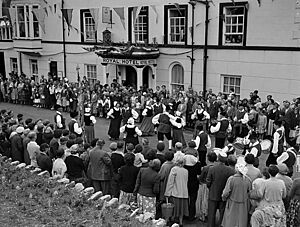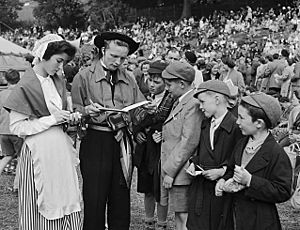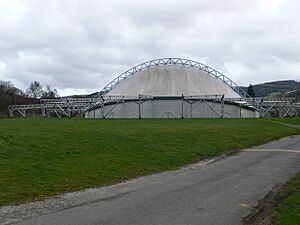Llangollen International Musical Eisteddfod facts for kids
Quick facts for kids Llangollen International EisteddfodEisteddfod Ryngwladol Llangollen (Welsh)
|
|
|---|---|

Rufus and Lucy Wainwright at the event in 2015
|
|
| Status | active |
| Location(s) | Llangollen |
| Country | United Kingdom (Wales) |
| Established | June 1947 |
| Participants | 4,000 |
| Attendance | 50,000 |
| Leader | Dave Danford |
The Llangollen International Musical Eisteddfod is a special music festival. It happens every year in July in Llangollen, North Wales. This event is one of several big annual festivals in Wales called Eisteddfodau.
Singers and dancers from all over the world come to take part. They compete in more than 20 different contests. Each evening, there are concerts on the main stage. Over 5,000 performers from about 50 countries entertain audiences. More than 50,000 people attend the 6-day event.
Many famous artists have performed at Llangollen. These include Luciano Pavarotti, who first competed here in 1955. The Eisteddfod's main award, the Choir of the World Pavarotti Trophy, is named after him. Other stars like Katherine Jenkins, Bryn Terfel, and James Galway have also performed.
Contents
How the Eisteddfod Started
The idea for the International Eisteddfod began in 1943. Harold Tudor, from the British Council, took some government leaders from other countries to the Welsh National Eisteddfod. This visit was a big success. One leader, Juraj Slavik, said music could help heal the world after war.
In 1945, Tudor suggested adding an international choir festival to the 1947 Welsh National Eisteddfod. However, the National Eisteddfod was busy rebuilding its own event. So, Tudor decided to create a new, independent music festival.
He found support from W. S. Gwynn Williams, a Welsh composer, and George Northing. Northing was a teacher and chairman of the Llangollen town council. Both wanted the festival to be held in their hometown of Llangollen.
The public in Llangollen liked the idea. They held meetings in May 1946 to discuss it. People wondered who would come, where it would be held, and how to pay for it. The British Council offered help, but the town decided to raise money themselves. They quickly collected over £1,100.
George Northing became the director, Gwynn Williams the music director, and Harold Tudor handled publicity. Plans for the event went ahead in 1946-47. Performers from overseas would stay in local homes. Welsh participants would sleep in church and school halls.
It was hard to get food during that time because of rationing. The organizers had to convince the Minister of Food to provide food coupons for all the visitors.
The First Festival in 1947
In June 1947, a railway strike in France caused problems. It was unclear if any overseas performers could arrive. Everyone was relieved when the first bus of competitors came. It brought the Grupo Musical Feminino, a ladies' choir from Porto. They won the Ladies Competition.
The Hungarian workers' choir won the Men's Competition. They had to hitchhike to Wales when their train was cancelled in Basel.
The Esperanto Society helped a lot in the first year. They spread the word in Esperanto magazines. This brought several groups to the Eisteddfod. Two Spanish dance groups, on a tour sponsored by the British Council and the Esperanto Society, also came. Even though there was no dance competition that year, they performed and delighted the audience. Folk dance competitions have been a part of every Eisteddfod since then.
The 1947 International Eisteddfod was a huge success. It even made a profit of £1,432 for the next year's event.
Building Bridges After War
In 1949, just four years after World War II ended, a choir from Lübeck, Germany, came to compete. This was a big step towards peace and friendship. The townspeople and Eisteddfod helpers gave them a warm welcome. They offered tea and sandwiches when the choir arrived.
The festival's host introduced them as "our friends from Germany." The town even held a concert to help the choir raise money. Members of that choir were still in touch with their Llangollen friends many years later.
The Eisteddfod Motto
The Welsh motto of the International Eisteddfod is "Byd gwyn fydd byd a gano. Gwaraidd fydd ei gerddi fo". The poet T. Gwynn Jones created it in 1946. This motto has been on Eisteddfod trophies and artwork for 75 years.
It is usually translated as: "Blessed is a world that sings. Gentle are its songs." The word gwyn in Welsh has several meanings, like "white," "pure," or "holy." It is used in the Bible to mean "blessed."
In 2023, some people thought the motto might be misunderstood. They worried it sounded like it meant the color "white." There was a suggestion to change it, but many people disagreed. So, the motto stayed the same.
Recent Performances
The Eisteddfod continues to attract famous performers. In 2007, José Carreras and Joan Baez performed. In 2008, it was Elaine Paige and Alfie Boe. The 2009 festival featured Barbara Dickson and Sir Willard White. That year also had a special James Bond 007 concert.
In 2010, Katherine Jenkins and Nigel Kennedy performed. The 2011 concerts included Lulu, Russell Watson, and the band McFly.
In 2012, the Eisteddfod celebrated the Queen's Diamond Jubilee. Performers included Lesley Garrett and Alison Balsom. There was also a performance of Karl Jenkins's new work, "The Peacemakers." The week ended with a Grand Finale Concert.
In more recent years, the Sunday evening concert has featured popular music. Bands like UB40, Status Quo (band), and Manic Street Preachers have performed.
The Eisteddfod Parade
A fun part of the Eisteddfod week is the parade. It usually happens on Tuesday. Locals and visitors join in, dancing, singing, and playing instruments. They march through the streets of Llangollen. In 2016, the parade was moved to Friday so more competitors could take part.
See also
- List of music festivals in the United Kingdom





